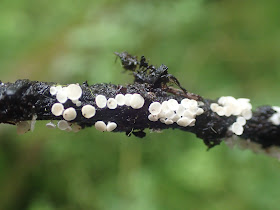Late June 2023
I had to delay June's WeBS count as there had been triathlons using the Great Broad. The wasn't anything particularly notable in terms of birds - 113 Greylag Geese, 57 Mute Swans (plus some cygnets in the conservation area bay) and 47 Egyptian Geese. A couple of Common Terns were also still present. In terms of invertebrates I saw my first patch Umbellifer Longhorn Beetle (Phytoecia cylindrica) and nice crab spider (Misumena vatia) and the smut on Greater Pond Sedge that has been very prevalent this year, Farysia thuemeni.























































